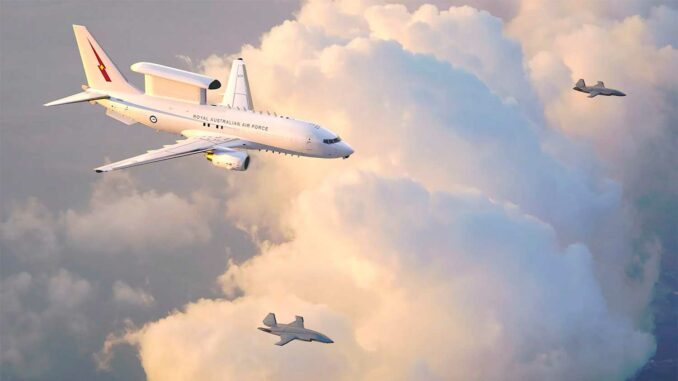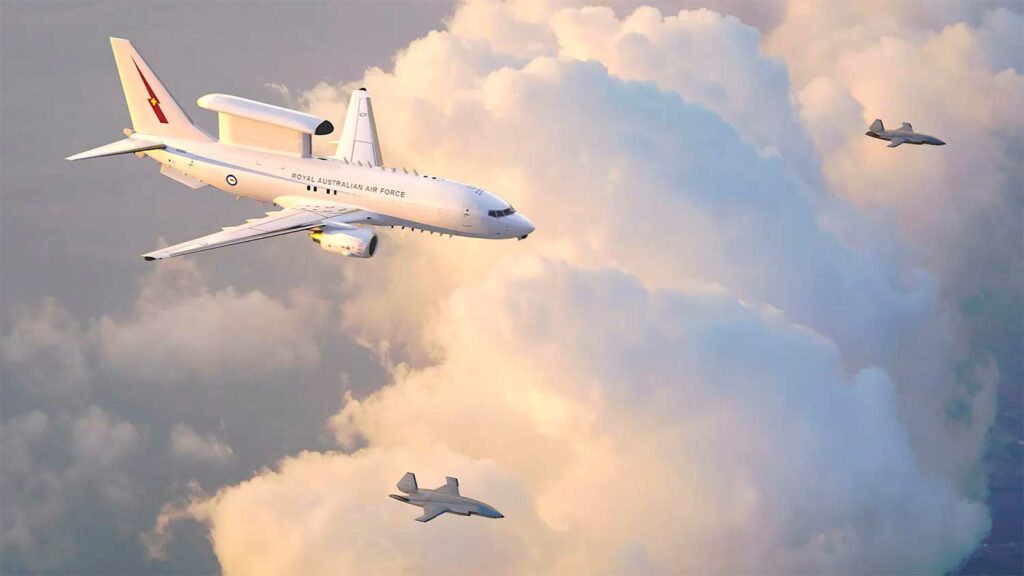
Australia is testing the MQ-28 Ghost Bat drone under the control of an E-7 Wedgetail, paving the way for a new doctrine of collaborative air warfare.
Australia has reached a technological milestone by testing the MQ-28 Ghost Bat combat drone, controlled from an E-7A Wedgetail surveillance aircraft. The test, conducted by the RAAF (Royal Australian Air Force), demonstrates the concept of human-machine integration in a modular architecture within a future mixed fleet of manned and unmanned aircraft. The MQ-28 is a drone designed by Boeing Australia, capable of performing protection, reconnaissance and interception missions in support of manned aircraft. The test validated the ability of a single operator aboard an E-7 to control multiple MQ-28 drones, including in simulated combat scenarios. This advance is part of the CD25 (Capability Demonstration 2025) program, which aims to redefine the doctrine for the use of drones in the RAAF. The project is receiving US$260 million in Australian government funding, along with the construction of a 9,000 m² production center. This experiment marks a step toward the implementation of a collaborative combat drone (CCA) model tailored to the strategic needs of Australia and its allies.

A collaborative combat drone for offensive and defensive missions
The MQ-28 Ghost Bat is a modular combat drone developed by Boeing Defense Australia as part of the Airpower Teaming System (ATS) program launched in 2019. This drone is 11.7 meters long with a wingspan of 7.3 meters and has an operational range of over 3,700 kilometers, according to the data provided. It is designed to operate in formation with manned combat aircraft such as the F-35A or F/A-18F Super Hornet, as well as command aircraft such as the E-7A Wedgetail.
The main feature of the MQ-28 is its ability to carry out surveillance, jamming, reconnaissance, and interception missions in direct cooperation with manned platforms. This approach meets the requirements of distributed air combat, where each platform plays a decentralized, often partially automated role.
The control system tested during this mission allows a single operator, aboard an E-7A, to take control of several drones simultaneously, using mission software developed jointly by Boeing, the Australian Defence Science and Technology Group, and the US Air Force Research Laboratory. This software integrates natively into the Wedgetail’s open architecture.
The MQ-28s are equipped with modular pods, including an interchangeable front nose that can accommodate an IRST-type infrared sensor, used to detect and track stealth or low-signature targets. The drone’s structure is designed to be adaptable to different mission profiles, depending on the threats and environment.
To date, eight Block 1 versions of the MQ-28 have been delivered to the RAAF, and three more are in production in a Block 2 configuration, which is expected to improve integration and autonomous processing capabilities. The program also includes live air-to-air firing tests, with a possible extension to air-to-ground munitions.
Operational testing in a real environment to validate the CCA concept
The test, conducted from an E-7A Wedgetail, engaged a simulated air target while integrating a third virtual drone into a digital environment. The entire test was conducted as part of the Capability Demonstration 2025 (CD25) program, which brings together several experiments coordinated throughout the year by the RAAF.
The MQ-28’s value in this context lies in its ability to protect vulnerable but critical platforms such as surveillance aircraft, refueling aircraft, and airborne command posts. Although equipped with advanced detection capabilities, these aircraft generally lack sufficient self-defense capabilities in contested environments.
With a squadron of Ghost Bat drones, an E-7A can repel a threat or detect an intruder while remaining at a distance. This loyal wingman role reduces dependence on manned fighters for escort, freeing them up for offensive missions. The concept also allows the MQ-28s to be used as sensor nodes, increasing the range and density of the surveillance network.
Future trials under CD25 will see the MQ-28 integrated with F/A-18F and F-35A aircraft to demonstrate full air-to-air coordination. The aim is to verify the ability to transmit orders, share radar tracks, and assign targets from a single command platform, whether manned or unmanned.
This experiment also serves to define procedures for engagement, command transfer, manual takeover, and link loss management. The challenge is to ensure that the system remains controllable at all times, while maximizing the tactical autonomy of the drones.

A structuring industrial program for Australian technological sovereignty
The MQ-28 program is not limited to a technology demonstrator. It is part of an industrial and capability strategy driven by the Australian government, which in 2024 invested an additional US$260 million (approximately €240 million) to accelerate the system’s development.
At the same time, Boeing Australia has announced the construction of a 9,000 m² industrial site to assemble future Ghost Bat drones. This site will also be used for maintenance, software updates, and the integration of payloads specific to Australian doctrine. This project strengthens the country’s technological base, reduces its dependence on foreign supply chains, and paves the way for gradual integration into the armed forces by 2027.
The drone’s modularity, with its open software architecture, also makes it possible to envisage the creation of a family of derivative drones with distinct capabilities: refueling, electronic warfare, ELINT sensors, or communication relays. This principle is similar to that of the Gambit program developed in the United States, or the “family of systems” concept promoted by the US Air Force.
However, the RAAF specifies that the Block 1 drones are not intended for direct service. They are validation prototypes. The Block 2 version could, if the government approves this direction, be the subject of an initial operational order in the coming years. Internal debates focus on the relationship between range, payload, decision-making autonomy, and unit cost.
Finally, the implications of this technology go beyond the national level. The MQ-28 program has been part of a bilateral cooperation with the United States since 2023. The US Navy is also interested in this type of drone to equip its future squadrons, particularly in the Indo-Pacific context. Australia is thus positioning itself as a strategic partner in the definition of future collaborative combat systems.
War Wings Daily is an independant magazine.